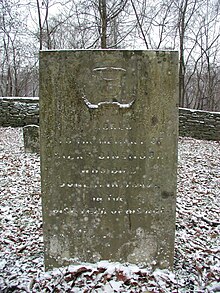Silas Dinsmoor

Silas Dinsmoor(September 26, 1766 – June 17, 1847) was an appointed U.S. Agent to theCherokee(1794–1798) and to theChoctaw(1801–1813). He later served as asurveyorinAlabamabefore eventually retiring toBoone County, Kentucky,where he is buried at theDinsmore Homestead.
Early life
[edit]Born inWindham, New Hampshire,Silas Dinsmoor was ofScots-Irishdescent. Dinsmoor was part of a large group of inter-related families who settled in southern New Hampshire in the early 1700s. Through his mother, Martha McKeen, he was related toJoseph McKeen,the first president ofBowdoin Collegein Maine. Dinsmoor was also a first cousin of Pennsylvania GovernorThomas McKean,a signer of the Declaration of Independence. Silas worked his way throughDartmouth Collegeby teaching, a profession he continued practicing after graduation. At nearbyAtkinson Academy,he taught a newly formed co-educational class of students, allowing young ladies to learn Logic, Greek, and Rhetoric - traditionally reserved for male students.
As agent to the Indians
[edit]In 1793, Dinsmoor traveled toPhiladelphiato look for a position with the government. Dinsmoor was offered the appointment of United States Agent to the Cherokee by PresidentGeorge Washington,a job that would last the next four years. In that capacity, Dinsmoor was expected to keep peace between the Cherokee and white settlers, serve as treaty commissioner, and introduce "civilization" to the Cherokee. This last task meant that Dinsmoor attempted to coax Cherokee men to take up farming, traditionally the occupation of Cherokee women, and to teach Cherokee women to plant cotton, spin, and weave textiles. Dinsmoor spent much of his time atTellico Blockhouse(in present-dayTennessee). As the agent, Dinsmoor witnessed the FirstTreaty of Tellico,signed in 1798 between the U.S. Government and tribal leaders, which signed away land in eastern Tennessee. Silas wrote to his brother then, "The Cherokees know the worth of their land too well to sell it for a song or anything under the value."
In 1798, when his term expired, Dinsmoor again went to Philadelphia in hopes of another post. Instead, in 1799, he accepted the job ofpurseron the naval frigate USSGeorge Washington.In that capacity, he sailed with the ship on a historic mission, it being the first U.S. warship to enter theMediterranean Sea.Under the command ofWilliam Bainbridge,the frigate was sent toAlgierswith trade items and tribute for theBarbary pirates.When they arrived in Algiers, theDeyordered the Americans to carry (under the flag of Algiers) an ambassador, several enslaved people, and exotic animals toConstantinoplefor theSultan of Turkey.
Returning to the states, PresidentThomas Jeffersonappointed Dinsmoor as Agent to the Choctaw, and he proceeded to the tiny outpost ofWashington, Mississippi Territory,located at the southern end of theNatchez Trace.It was presumed Dinsmoor would carry out a similar set of tasks as before, expecting to encourage the Choctaw to cede large sections of their land to the U.S. government. Again, the Choctaw were unwilling to give up their most valuable lands. TheTreaty of Mount Dexter,signed in 1805, sold away more than four million acres of Choctaw land in southeastern Mississippi and parts of Alabama; this angered Jefferson because he wanted more valuable lands along the Mississippi River. Dinsmoor also witnessed theTreaty of Fort St. Stephensof 1816 and theTreaty of Doak's Standof 1820. By this time, though, he was no longer serving as an agent.
In 1811, Dinsmoor found himself embroiled in a controversy withAndrew Jackson,and by 1813, he was looking for a new government post. The controversy began with reports from the Natchez region that enslaved people were being encouraged to run away by traders from Tennessee. Dinsmoor was asked to protect the property of the local planters, and he began instituting an often-ignored requirement that anyone traveling the Natchez Trace carry papers with them proving their ownership of any enslaved people they claimed. Jackson refused to do so and became quite furious when he heard Dinsmoor was vigorously enforcing the rule, at one point threatening to arm the people he enslaved on his next time through, kill Dinsmoor, and burn the agency house to the ground. Though he never found the right moment to carry out his threat, his messages to the War Department may have had something to do with Dinsmoor being replaced in 1813.
Dinsmoor was elected a member of the American Antiquarian Society in 1813.[1]
Later life
[edit]Dinsmoor moved with his wife, Mary Gordon, and children toSt. Stephens,the capital of theAlabama Territory,and then toMobile.He served as a principal surveyor for the land office in New Orleans. Again, he had personal troubles with his superior, George Davis, and was let go. Suffering financially from unpaid wages and a debt he had incurred as security for a friend, he was forced to go toWashington, D.C.in 1826 to plead for money. While he was away from Mobile, he learned of the death of a son and the burning of the bank where he had stored his valuable surveying journals, business papers, and a silver swordWashingtonhad presented to him during a visit toMount Vernonin 1798.
In 1829, he moved toCincinnati, Ohio,and a year later, he purchased land in Boone County, Kentucky. The approximately 100-acre purchase included an orchard, a cabin, and Loughery Island in theOhio River.He lived here with his wife and son, Thomas, until he died in 1847. He was buried in the family graveyard of his nephew, James Dinsmore, which is now part of the Dinsmore Homestead. The papers he left are housed at Dartmouth.

References
[edit]
McLoughlin, William G.Cherokee Renascence in the New Republic.Princeton: Princeton University Press, 1986.
Remini, Robert V.Andrew Jackson and the Course of American Empire, 1767-1821.New York: Harper & Row, Publishers, 1977.
Pate, James P. (Editor),The Reminiscences of George Strother Gaines: Pioneer and Statesman of Early Alabama and Mississippi, 1805-1843.Tuscaloosa: The University of Alabama Press, 1998.
External links
[edit]- The Papers of the Dinsmore Familyat Dartmouth College Library
